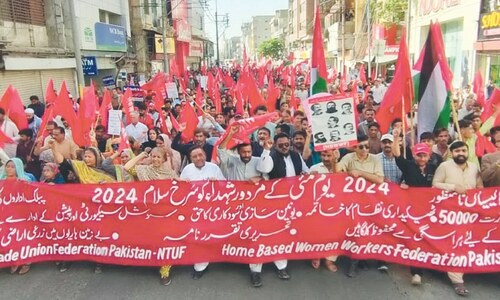PROF Gian Chand Jain in his remarkable research work Urdu Ki Adabi Tareekhen, or Urdu’s literary histories, has critically evaluated 27 major and 16 minor histories of Urdu literature. And it does not include Safeer Bilgirami’s Jalwa-i-Khizr (1884).
It means Gian Chand either did not consider Jalwa-i-Khizr worth taking note of or ignored it because of its dated style of writing that resembled an old-fashioned literary ‘tazkira’ rather than a modern-day literary history. In this book Prof Jain has severely criticised Muhammad Hussain Azad’s Aab-i-Hayat (1880) and, having pointed out its glaring errors, he concludes that Azad was not a literary historian but had committed “forgery” (referring to ghazals that Azad himself had composed and included them in Zauq’s divan) (page 99). Jain says that Azad has distorted facts, concocted events or twisted them to suit his point of view and no other book has as much damaged literary history as did Aab-i-Hayat. The last lines of this conclusion say that in libraries Aab-i-Hayat should not be placed on the shelves reserved for literary histories or ‘tazkiras’, but on the shelf labelled “fiction” (page 100).
A ‘tazkira’ is an account of Urdu poets and their poetry, with a brief life sketch of poets and their selected verses along with occasional, brief critical views. But ‘tazkiras’ fell out of favour and fashion in the beginning of the 20th century and now ‘tazkiras’ are considered, generally, lacking in accuracy and/or details. But at the same time, one has to admit, some ‘tazkiras’ are the only source on some important literary information and without them many pieces of our literary history puzzle would have been unsolved forever.
Jain declares that Azad’s status as a historian is “not better” than writers like Safeer Bilgirami, Shad Azeemabadi, Naseer Hussain Khayal and Mufti Intizamullah Shahabi (page 100). These are the writers mostly considered unreliable and referring to them in a research work may raise reviewers’ or examiners’ hackles.
But, the question is: if Azad is so unreliable, why did Jain spare 65 pages to analyse Aab-i-Hayat? And if Aab-i-Hayat was included in his book, why did Jain leave Jalwa-i-Khizr out?
What I want to emphasise here is that Jalwa-i-Khizr is a history of Urdu literature that has its merits, albeit it is not without demerits. Jameel Jalibi’s history of Urdu literature is one of the great works, a fact admitted by Jain in this book. But Jalibi Sahib has quoted Jalwa-i-Khizr scores of times in his history’s third and fourth volumes, although in the first two volumes he has quoted it only on few occasions.
What prompted Safeer Bilgirami to write Tazkira-i-Jalwa-i-Khizr? Azad’s Aab-i-Hayat covers five eras of Urdu poetry and ends with analysing works by Ghalib, Dabeer and Anees. Safeer thought it was a kind of injustice to the poets who wrote poetry after these giants. So he decided to write a new, comprehensive history of Urdu literature and named it Jalwa-i-Khizr, alluding to the guidance attributed to the legendary character of Khwaja Khizr.
As put by Safeer, he was trying to complement and complete the account of Urdu poets and poetry that was left incomplete by Muhammad Hussain Azad. Safeer intended to write it in three volumes. The first volume appeared in 1885, though the print line mentioned 1884. But after the publication of the second volume in 1890, Safeer died and the third volume was left incomplete.
Most critical views on Jalwa-i-Khizr cannot be termed favourable. Syed Abdullah wrote that Safeer has obtained much from Aab-i-Hayat. Dr Zafar Uganvi wrote that though Safeer indeed could not surpass as far as the style and scheme of chapters are concerned, his contribution cannot be ignored as he has corrected Azad on many occasions and has added new information on several issues. The addition of information on some poets not included in Aab-i-Hayat, too, is commendable. Another contribution for which Safeer deserves kudos is his discussion and comments on words and idioms declared ‘obsolete’ and/or ‘archaic’ by some.
Another famous history of Urdu poetry is Shear-ul-Hind. Written by Abdus Salam Nadvi, its first volume appeared in 1925 and the second one in 1926. For arguments on Urdu’s so-called ‘obsolete’ idioms, Abdus Salam Nadvi has relied solely on Jalwa-i-Khizr, says Moulvi Abdul Haq. This simply shows that Jalwa-i-Khizr left its impact despite all the criticism.
Safeer Bilgirami was a literary historian, poet, critic and prose writer. Born Syed Farzand Ahmed on April 7, 1834, in Marehra, UP, Safeer began composing poetry in Urdu and Persian at an early age and became Ghalib’s pupil for guidance in poetry. He also went to Delhi to see Ghalib and both exchanged letters. Ghalib’s letters addressed to Safeer have also been published.
His other books include Rashhaat-i-Safeer, Mehsharistaan-i-Khayal, Jauher-i-Maqalaat (novel), Risala-i-Tazkeer-o-Tanees, Safeer-i-Bulbul (Urdu divan) and some other poetical works. Safeer Bilgirami died on May 12, 1890, in Patna and was buried in Aara (Bihar).
A new edition of Jalwa-i-Khizr was published from Karachi by Safeer Bilgirami Academy. The first volume was published in 2009 and the second in 2011. Jalwa-i-Khizr is especially recommended to those who want to read some delectable select Urdu couplets with a touch of idiomatic expressions.
Published in Dawn, May 5th, 2020














































Dear visitor, the comments section is undergoing an overhaul and will return soon.